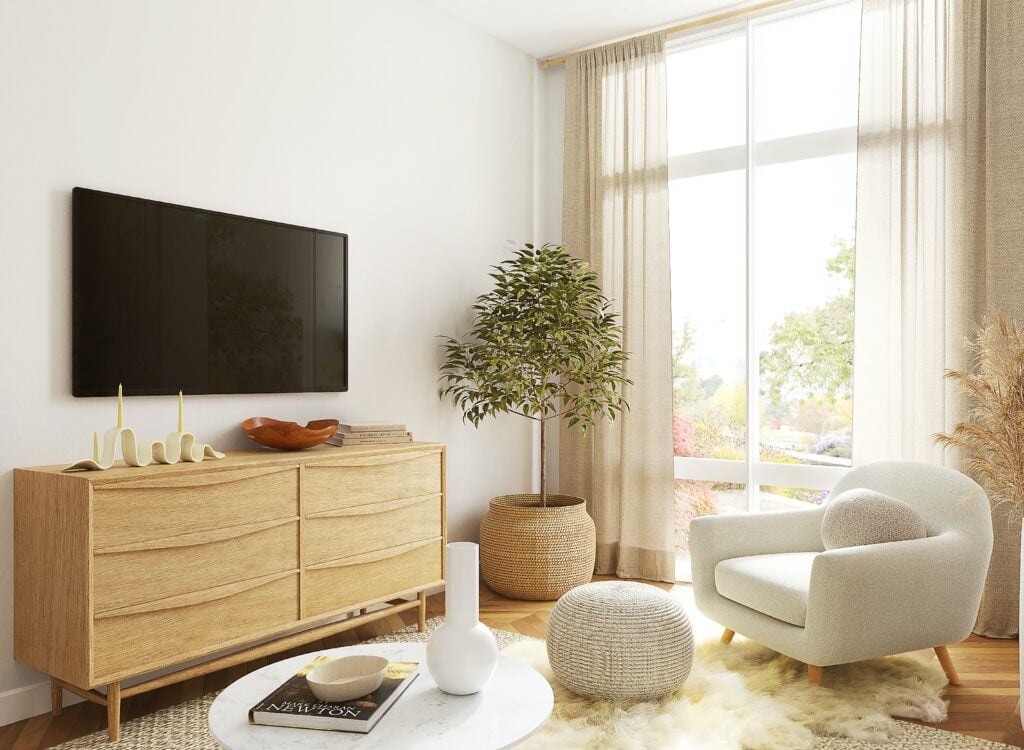How to Design Your Home for Maximum Health & Longevity

No, we’re not talking about helping your home or furnishings last longer. (You didn’t accidentally find yourself on a real estate blog…) Rather, we’re talking about things you can do to improve your longevity and health span just by how you design your home.
As we’ve learned from research on the “Blue Zones,” long, healthy lives don’t happen because of fad diets or intense fitness routines. Rather, they are often due to our consistent habits and how we live our lives over the years. And to help make better choices, whether your home is a tiny apartment, a large house, or something in-between, you can deliberately design where you live to support a healthier lifestyle and better choices.
For instance, how many decisions do you think you make every day when it comes to the food you eat? If you’re like most people, your answer will be somewhere around 15 decisions. The real answer is significantly more. In fact, researchers in Nutritional Sciences from Cornell have found that we make more than 200 decisions around the food we eat every day. It’s just that most of them are made on autopilot and are determined by environmental cues. 1
Wouldn’t it be awesome to nudge those automatic decisions to make healthier choices? Fortunately, you can!
There are numerous small (and big) things around us that we can adjust to influence our decisions, such as:
- Plate size
- Package size
- People in our surroundings
- The foods we keep in the house
- Distractions
- And more
In short, we can make it way easier to eat right by changing our environmental cues to work for us. And, there are several other ways to help design the home to help maximize health.
How to Design Your Home for Health and Longevity
Ready to make some changes for good? Great! Here are some of the top suggestions from the experts:
1. Move Your TV
If your TV is viewable from your kitchen (open concept!), move it to another room. It’s easy to keep munching long past feeling satisfied when enjoying your favorite show (or just watching something because it’s on…) when you can just casually drift into the kitchen without thought.
Just keeping your TV in a room that’s not adjacent to your kitchen can help you cut back on mindless snacking as you have to consciously press pause and get up to grab your next snack. It can also encourage you to get in some steps if you decide you really do want to refill your popcorn bowl or grab another drink.
2. Set Your Kitchen Up for Success
Healthy meal prep is vital for a healthy life. Set out foods like veggies and fruits, so they’re easy to see and thus eat. And then keep an area in the kitchen cleared of clutter that’s easy to keep clean for healthy meal prep. It’s also a good idea to make sure you can get to small appliances that help make healthier meals more accessible. That may include your blender, a small food processor, and a toaster oven that allow you to throw together food that will nourish you over foods that are just convenient.
An organized pantry and fridge also allow you to more easily see what you have on hand and can help nudge you to make healthier choices. Keep the processed foods you want to limit out of sight and bring the nutrient-dense foods front and center and easy to access or inspire you to make a nourishing meal. For instance, keep your fruit and cut-up veggies at eye level, so you see them immediately when you open the fridge. Or have a fruit bowl on the counter to grab a piece before you head out.
3. Go Low
In Northern America, many of us tend to prefer larger furniture that’s easy to get in and out of. In other (typically longer-lived) countries, they choose lower sofas and chairs—or even sit on rugs or pillows on the floor. Getting up and down off these low surfaces essentially equates to deep squatting regularly throughout the day. In return, people who sit on lower surfaces typically have stronger leg and glute muscles, better balance, and improved flexibility.
The least expensive option is to remove your large furniture and instead choose to sit on pillows on the floor. But if that’s neither comfortable nor aesthetically pleasing, you can choose low furniture that provides relaxed seating combined with the benefits of getting closer to the ground. And you can find a variety of options from traditional furniture to more modern or bohemian furniture that suits any style.
It may take a minute to get used to a new way of sitting but can benefit you for years to come.
4. Light It Up
Upgrading your lighting to LEDs can save on electricity and make your home more cheerful and inviting, especially in the winter months. Improved lighting can also help reduce eye fatigue when you’re busy with a task. Plus, adding some LED nightlights can help you navigate your home without tripping if you wake up in the night.
5. Remove Tripping Hazards
Speaking of tripping, one of the biggest concerns as we age is a fall that can lead to a broken bone (e.g., hip) or torn ligament or muscle (e.g., shoulder). To help promote health and longevity, look through your house and remove any tripping hazards, such as bunched-up rugs, cords, shoes, bags, or pet bowls.
Make sure any rugs have a slip-resistant mat to hold them firmly in place. The same goes for bathrooms as floors can become slippery when wet. Add slip-proof tiles or grab bars for the shower. You may even want to add a bench for bathing as you age to help prevent dangerous falls.
6. Declutter
Decluttering your home can also help by removing furniture or belongings that can trip you up. Clutter (on surfaces beyond the floor) can also collect allergy-inducing dust. So, look around and see if there’s any trash or disorganized spaces you can clean up or remove altogether for both mental and physical health benefits. As a bonus, removing excess belongings can make it easier to keep your home neat and tidy.
7. Share Your Meals
Eating your meals with others can help you slow down and eat more intentionally. This can give your body enough time to register when you’re full, so you don’t continue to eat more than you need. It can also remove the distraction of TV and help you focus on connecting with others, which is one of the best things you can do to improve your health.
Don’t just stop at meals for improving your social ties. Having conversation nooks inside and out of your home can nudge you to get to know friends and neighbors better. So, for instance, if you have a front porch, make it an inviting place to gather and then invite people to join you.
8. Grow (Some of) Your Own Food
You don’t need a lot of outdoor space to start a small container garden. You can even grow some herbs, sprout some seeds, or tend a few vegetables from your porch, terrace, or window box. And if you have the space, you can expand to a salad garden and beyond.
Taking care of plants in your garden provides several health benefits, such as increasing activity levels when you water and weed your plants), helping you slow down and be more present with living things, grounding with the earth, and of course, eating foods that are freshly grown.
9. Create Room to Move
Even if you love going to the gym, having space in your home to move your body can help you fit in exercise when you can’t get out—due to weather, time constraints, or other issues. Even having just enough space for a yoga mat can allow you to stretch your body, get in a quick exercise session on a busy day, or provide a space to relax and meditate when you’re stressed.
10. Slip Off Your Shoes
Keeping a pair of house shoes by the door can help keep dust and dirt out of your home. Better yet, it can help you leave the unhealthy bacteria that you pick up from walking around in the big bad world outside.
In addition, if you keep your walking or running shoes by the door, it can help remove one excuse from being more active as they’re right there, front and center, to encourage you to get out and move.
While you’re at it, you can create a landing zone to hang up any bags or coats and a convenient place to leave your keys, sunglasses, and other necessities you need when you head out. This also helps you better avoid tripping hazards near walkways as well as the frustration or anxiety that comes when you can’t find your keys, wallet, etc.
RELATED: How to Get Keto Results WITHOUT the Keto Diet
11. Bring the Outside In
While you want to leave dirt and germs at the front door, one way to make your home healthier is to bring the outside in. Indoor plants may help improve air quality. Better yet, they can help decrease stress levels. Many of the best plants don’t require a lot of care if that’s a concern. If, however, you find that you don’t have a green thumb, you can also bring in earthy colors, natural woods and fibers like jute, cotton, wool, or silk, and landscape photos or paintings as decorations to help you better connect with nature (known as biophilic design).
Don’t forget to fling open the curtains or blinds to bring in natural light during the day (weather and view permitting). On nice days, go a step further and let the fresh air in by opening windows and doors when possible.
12. Purify the Air
Indoor air pollution can have a significant effect on your health. And recent research has found that the air we breathe inside is often a lot dirtier than the air we breathe when outside. Air purifiers use internal fans to help pull harmful bacteria, dust, and allergens out of the air to make it easier and healthier to breathe indoors. Consider adding one to the areas of the home you spend the most time in. Just remember to regularly clean out the filters, so they continue to work optimally.
13. Create a Bedroom Sanctuary
One of the most important aspects of a healthy life is great sleep. Making your bedroom cool and dark, with minimal distractions (especially those with screens, such as TVs and tablets) can help improve your quality of sleep, which provides everything from improved heart health to better brain functioning. Adding blackout curtains and white noise can help promote a calm, relaxing place to gently drift away to dreamland.
Enjoy decorating the space in a way that’s peaceful and promotes happiness for you, such as with soft linens, comfortable pillows, and minimal clutter. And cover indicator lights (especially those that blink) as often found on surge protectors, clocks, and air purifiers, with electrical tape to prevent sleep disruptions.
In addition, removing dust and dirt can help you breathe better as you sleep and help reduce allergens. Even making your bed in the morning can help your sleep room feel more like a sanctuary.
Design Your Home for Longevity
When it comes to the world around you—from your office to the grocery store and even the neighborhood you live in—there’s not a lot you can do to change the environment to better suit you. That totally changes in your own home. Sure, you may need to negotiate with family or roommates, but you can still make subtle (or dramatic) changes to help improve your health… and theirs. And it doesn’t take a full-scale reno to make it happen.






 7 Signs Your Body is Seriously Low on Collagen (not just wrinkles)
7 Signs Your Body is Seriously Low on Collagen (not just wrinkles) Health Expert: "Turmeric Doesn't Work (unless...)"
Health Expert: "Turmeric Doesn't Work (unless...)" 3 Warning Signs Your Probiotic Supplement is a Total Waste
3 Warning Signs Your Probiotic Supplement is a Total Waste

